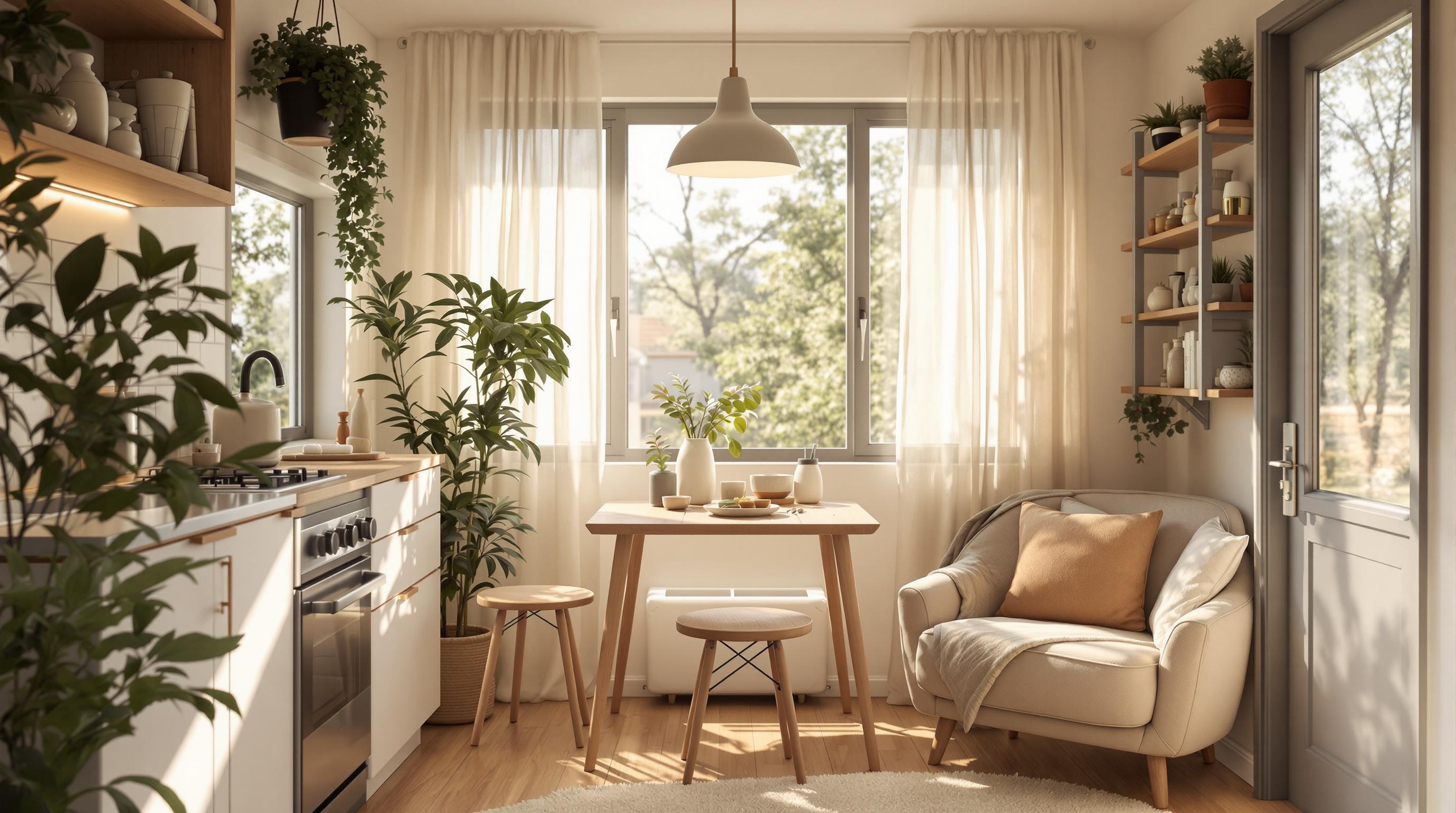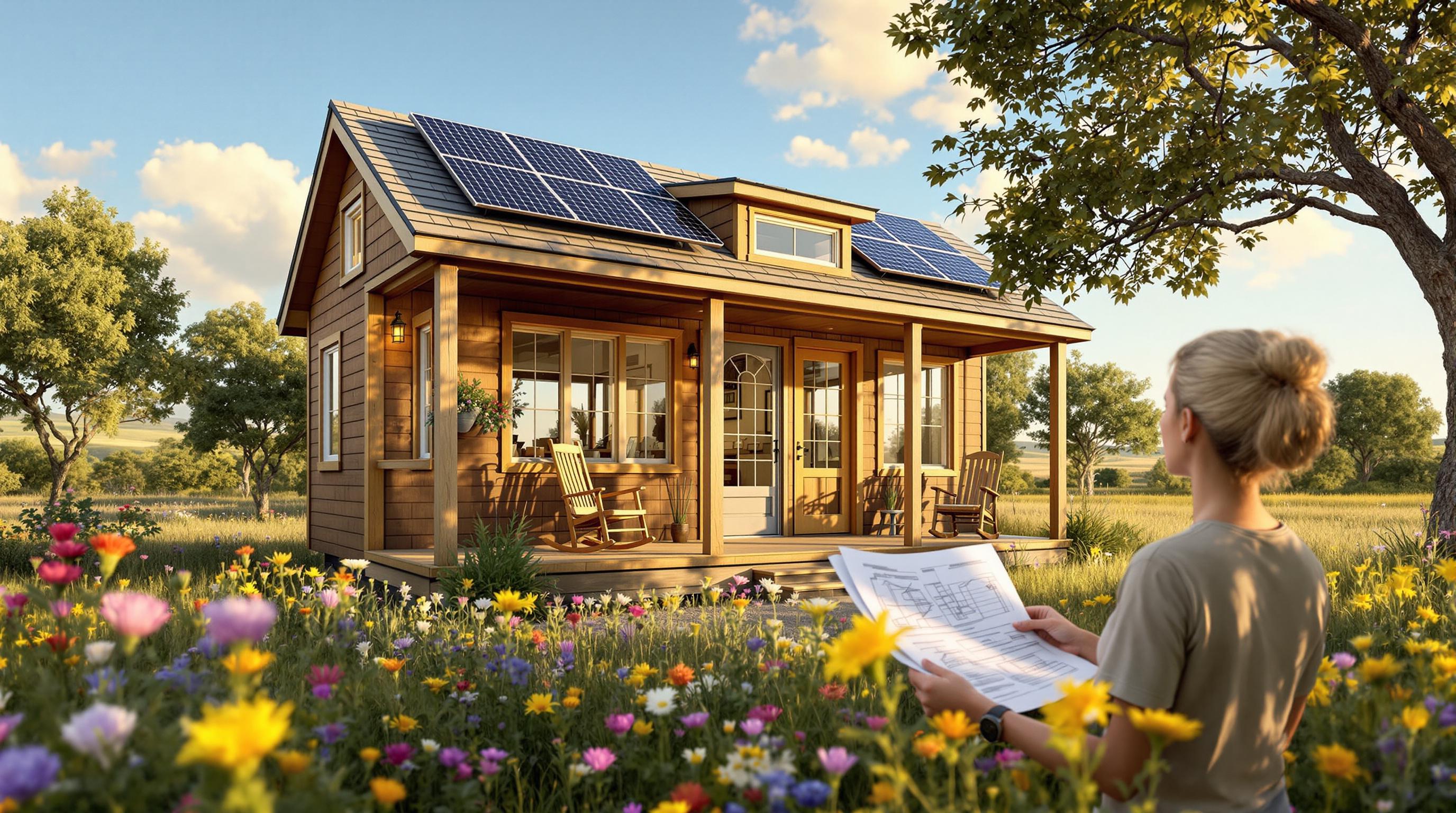Thinking about renting a tiny house? Here's what you need to know:
- Cost: Monthly rent is typically $800–$1,000, but hidden costs like zoning fees, maintenance, and utilities can add up.
- Space: Tiny houses range from 100–400 sq. ft., offering compact living with clever storage but limited room for families or social activities.
- Energy Efficiency: Many include solar panels and energy-saving appliances, reducing utility bills by up to 45%.
- Mobility: Tiny houses on wheels allow flexibility, but moving costs ($1–$3/mile) and zoning restrictions can be challenging.
- Hidden Costs: Be prepared for permit fees, weatherproofing, and specialized repairs that may increase expenses.
Tiny houses are ideal for minimalists or eco-conscious renters, but they come with trade-offs like limited space and potential extra costs. Weigh the pros and cons carefully before making the leap.
1. Tiny Houses For Sale, Rent, and More
Cost Considerations
Renting a tiny house typically costs between $800 and $1,000 per month, making it an appealing option for those looking to save on housing expenses [2].
Space and Accessibility
Tiny houses, ranging from 100 to 400 square feet [1], require thoughtful design to accommodate daily activities. While their compact size can pose challenges for families or individuals with mobility concerns, clever storage solutions and multifunctional furniture help make the most of the available space.
| Area | Key Features | Challenges |
|---|---|---|
| Living Space | Multi-purpose furniture | Limited room for social activities |
| Sleeping Area | Loft or ground-floor options | Loft access may be difficult |
| Kitchen | Space-saving appliances | Minimal counter and storage space |
| Bathroom | Composting or standard toilets | Tight shower areas |
Energy Efficiency and Utilities
Many tiny houses come equipped with solar panels and energy-efficient appliances, helping to lower utility bills while appealing to renters who prioritize eco-friendly living [2][3]. This aligns with the movement's emphasis on reducing environmental impact.
Location and Mobility
Tiny houses on wheels offer flexibility for remote workers, travelers, and those seeking adventure [1][2][3]. However, zoning laws can limit where these homes can be placed. To navigate these restrictions, renters can collaborate with tiny house communities or property managers. While the mobility of these homes is a big draw, renters should also account for potential hidden costs, which will be discussed next.
Related video from YouTube
Advantages and Disadvantages
As tiny houses gain popularity, it's important to weigh their pros and cons before deciding to rent one.
Financial Considerations
Renting a tiny house can be easier on your wallet, with monthly costs typically falling between $800 and $1,000. However, it's crucial to consider potential extra expenses, such as zoning fees or maintenance costs, which could add up over time.
Environmental Impact
Tiny houses can shrink your ecological footprint by 45%, mainly due to reduced energy consumption and eco-friendly design options [3].
Here's a closer look at the key advantages and disadvantages:
| Advantages | Disadvantages |
|---|---|
| Lower utility bills | Limited storage space |
| Mobility and flexibility | Tight living quarters |
| Reduced energy use | Smaller appliances and fixtures |
| Affordable to furnish | Difficult-to-access lofts |
| Easier upkeep | Zoning restrictions |
| Lower rental costs ($800–$1,000/month) | Less privacy |
| Energy-efficient design | Uncertain resale value |
| Encourages a minimalist lifestyle | Susceptible to weather challenges |
Practical Considerations
Whether a tiny house rental suits you depends largely on your lifestyle. For remote workers or those embracing minimalism, the compact space might be worth the financial and environmental perks. On the other hand, families or those who frequently host guests may struggle with the limited room.
While this overview highlights the main pros and cons, it's essential to factor in hidden costs when making a final decision.
sbb-itb-2ef3f3a
Hidden Costs You Should Know
Renting a tiny house might seem budget-friendly at first glance, with monthly rents ranging from $800 to $1,000. However, there are often extra costs that can catch you off guard. Here's a closer look at what to consider when planning your budget.
Zoning and Permit Expenses
Beyond the usual zoning restrictions, you may encounter permit fees that vary depending on your location. These fees can add up to hundreds of dollars each year. In some areas, you’ll also need to renew special residential permits annually, which can further increase your costs.
Utility and Climate Costs
| Utility Type | Monthly Cost Range |
|---|---|
| Off-Grid Solar | $200-$500 initial setup |
| Traditional Grid | $50-$150 |
| Water Systems | $30-$100 |
| Propane | $40-$80 |
Tiny houses often use less energy - up to 45% less than traditional homes [3]. However, depending on your location, you might need to invest in extra insulation or storm-proofing, especially if you live in an area with extreme weather. These adjustments can add to your upfront expenses.
Maintenance and Repairs
Maintaining a tiny house isn’t always straightforward. Systems like HVAC and custom-sized plumbing often require specialized servicing, which can make repairs 20-30% more expensive compared to standard homes. Weatherproofing is another key consideration, especially for mobile units, to protect against wear and tear.
Insurance and Transportation Costs
"Insurance and liability costs can be higher for tiny houses due to their unique nature and potential for damage during relocation", according to ExactEstate's property management analysis [2].
If you plan to move your tiny house, transportation costs can add up quickly - expect to pay $1 to $3 per mile. On top of that, preparing and setting up your new site can cost anywhere from $1,000 to $2,000. These expenses are especially important to factor in if frequent moves are part of your plan.
Practical Considerations
While tiny houses can save money on energy and rent, these hidden costs might make a bigger dent in your budget than expected. Being aware of these expenses can help you decide if tiny house living truly fits your financial and lifestyle needs. Proper planning ensures you're not caught off guard by unexpected costs.
Final Thoughts
Now that we've looked at the hidden costs, it's time to weigh whether tiny house living fits your lifestyle and financial goals. While monthly rents ranging from $800 to $1,000 might seem affordable compared to traditional housing, there's more to consider than just the price.
Living in a tiny house means embracing a smaller space, which changes how you go about daily life. Your success in this setup depends on your comfort with minimalist living, adjusting to compact appliances, shared spaces, and clever storage solutions. This lifestyle is especially appealing to those who prioritize simplicity and care about reducing their environmental impact.
One of the biggest perks of tiny house living is mobility. You can move with ease, making it a great option for temporary housing or exploring new places. But this flexibility comes with a few challenges to keep in mind:
- Preparing the site and obtaining permits
- Meeting unique insurance requirements
- Navigating local zoning laws
- Adjusting to different climates
- Finding reliable maintenance services
Using solar panels and energy-efficient systems can help you stay energy-independent while keeping modern comforts intact [1]. However, these options often require a bigger upfront investment and a commitment to sustainable habits.
Before diving in, consider how tiny house living aligns with these factors:
- Your personal lifestyle and preferences
- Financial situation and budget
- Long-term housing plans
- Comfort with minimalism
- Desire for mobility
It's not just about living in a smaller space - it's about embracing a whole new way of life. With thoughtful planning and realistic expectations, renting a tiny house could be an eco-friendly and cost-effective housing choice that matches a minimalist lifestyle.
If you're unsure, try speaking with current tiny house renters or spend some time in a rental to test it out. This hands-on experience can give you a clearer picture of whether this unique housing option works for you.
FAQs
How much can you make renting out a tiny home?
Rental income for tiny homes typically ranges between $50 and $200 per night for short-term stays. The exact amount depends on several factors:
| Factor | Effect on Rental Income |
|---|---|
| Location | Homes near popular attractions or amenities tend to earn higher rates. |
| Quality of Finishes | Premium materials and modern designs can justify higher rental prices. |
| Added Features | Extras like patios, fire pits, or hot tubs can significantly boost rental value. |
| Seasonality | Peak tourist seasons often lead to increased demand and higher nightly rates. |
The tiny house rental market is expected to grow by 57% in North America by 2027 [4], offering a lucrative opportunity for property owners who focus on effective marketing and choose the right location.
To maximize income potential:
- Promote eco-friendly features to attract sustainability-focused renters.
- Keep the property well-maintained for better reviews and repeat bookings.
- Explore both short-term and long-term rental options depending on your area.
- Capitalize on the trend of minimalist living experiences.
With an average cost of $52,000, tiny homes are about 87% cheaper than traditional houses [5]. For those considering tiny homes as an investment or living option, understanding these factors can help you decide if renting one aligns with your financial and housing goals.



